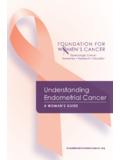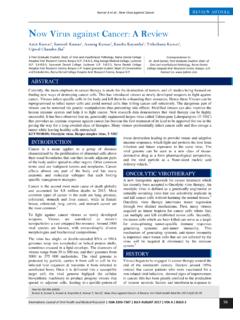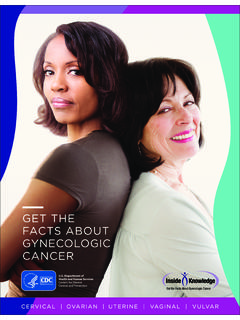Transcription of Screening for Cancer of the Cervix
1 Screening for Cancer of the CervixCervical Cancer Screening ProgramJune 2017An Office Manual for Health Care Providers of Contents IntroductionProtocols for Cervical Cancer ScreeningScreening Recommendations for Individuals at High Risk ofDeveloping Cervical CancerBenefits and Harms of Cervical Cancer ScreeningRole of the Health Care ProviderPap Sampling TechniqueCompleting the Gynecologic Request FormEducational MaterialsFeedback and Ordering Supplies345789121516 IntroductionThe Cervical Cancer Screening Program (CCSP) is an organized Screening program that works to reduce cervical Cancer incidence and Cancer Agency (BCCA) and PHSA Laboratories provide medical and operational leadership for both the program and the Cervical Cancer Screening Laboratory (CCSL).
2 Cervical Cancer Screening tests have a potential for false negative and false positive results. If your patient has any clinically suspicious lesions, abnormal bleeding or other relevant symptoms, further evaluation is required even if the test result is of the Cervical Cancer Screening ProgramRecruitment and Retention Screening PolicyIn a true population-based Screening program, all eligible individuals are invited to participate. At this time, recruitment to cervical Cancer Screening is opportunistic, in that family doctors and other health care providers initiate the sample collection from their patients.
3 The sample is sent to the laboratory (CCSL) for processing and interpretation. The program s centralized registry coordinates a system of recall by sending reminders to health care providers based on the appropriate Screening interval recommendation for each Laboratory ServicesCCSL processes and interprets approximately 550,000 tests annually. The laboratory distributes Pap test sampling supplies to health care providers at no Assurance and Quality ControlCCSL demonstrates an ongoing commitment to providing quality patient care by following internationally recognized standards of excellence in lab practices.
4 The laboratory participates in on-site accreditation inspection by the College of American Pathologists. EvaluationData is collected and analyzed on an ongoing basis to Smonitor the program s effectiveness and to identify areas of improvement. The program publishes an annual report every year. The report can be accessed ServiceThe Provincial Colposcopy Service investigates women with abnormal results. If recommended, women should be referred promptly for colposcopy. A copy of the cytology report must accompany the referral letter. More information and the list of regional colposcopy clinics are available at: 3In addition, CCSL has submitted an application for accreditation by the College of Physicians and Surgeons of the British Columbia Diagnostic Accreditation Program.
5 To ensure continuous quality improvement, CCSL monitors and evaluates quality indicators and obtain clinician feedback on a regular basis through a variety of aims to identify high-grade pre-cancerous lesions which can be treated to prevent the development of cervical Cancer . High grade lesions may be treated with ablative and excisional therapies, including laser ablation, loop electrosurgical excision procedure (LEEP) and cold knife conization. Cervical Cancer may be treated with surgery (hysterectomy) and/or radiation +/- for Cervical Cancer Screening * Sexual contact includes intercourse as well as digital or oral sexual contact involving the genital area of a partner of either gender.
6 Including removal of Cervix , with no history of pre-cancerous lesions or cervical Cancer . Provided there are 3 negative tests in preceding 10 years and no high risk criteria. Immunocompromised includes those diagnosed with human immunodeficiency virus (HIV/AIDS), lymphoproliferative disorders, an organ transplant, and those under long-term immunosuppression RecommendationScreeningTestScreeningInte rvalBalance of Screening Harms and Benefits Age 25-69 ScreenCytology3 yearsBenefits outweigh harmsNever had sexual contact*Do not screenNo testN/AHarms outweigh benefitsHave received the HPV vaccineScreenCytology3 yearsBenefits outweigh harmsIn same sex relationshipScreenCytology3 yearsBenefits outweigh harmsTransgender with a cervixScreenCytology3 yearsBenefits outweigh harmsAfter total hysterectomy Do not screenNo testN/AHarms outweigh benefitsAge < 25Do not screenNo testN/AHarms outweigh benefitsAge > 69 Do not screenNo
7 TestN/AHarms outweigh benefitsImmunocompromised women ScreenCytologyAnnualBenefits outweigh harmsHistory of pre-cancerous lesions or cervical cancerScreenCytologyPlease see section on Screening Recommendation for Individuals at High Risk of Developing Cervical CancerBenefits outweigh harmsAverage RiskHigher than Average RiskCategories4 Screening Recommendations for Individuals at High Risk of Developing Cervical CancerImmunocompromised individuals and those previously treated for dysplasia are considered at high risk of developing cervical Cancer and should be screened annually. Individuals currently being assessed by a colposcopy clinic or being followed by a Cancer clinic should not undergo additional cervical Cancer Screening unless directed by the treating table below outlines Screening recommendations based on expert opinion, as there is currently insufficient data to support evidence-based cervical Cancer Screening recommendations for individuals at higher than average risk of developing cervical Cancer .
8 Category Screening Recommendation Return to Normal Screening After Screening Stop Age Immunocompromised Individuals: Higher than Average Risk Immunocompromised Individuals Including those with human immunodeficiency virus (HIV/AIDS), lymphoproliferative disorders, organ transplants, and those under long-term immunosuppression therapy Annual Screening Never The benefits of Screening beyond age 69 must be weighed in the context of the overall health of the patient Previous histological diagnosis of CIN 2+: CIN 2+ (not including AIS): treated (cone, LEEP, ablative therapy), HPV negative, discharged from colposcopy Follow average risk guidelines N/A Age 69 or 25 years since most recent diagnosis with 3 Paps with no significant abnormality* in last 10 years whichever occurs later CIN 2+ (not including AIS): treated (cone, LEEP, ablative therapy), HPV positive, discharged from colposcopy Annual Screening At least 3 negative Paps in last 5 years Age 69 or 25 years since most recent diagnosis with at least 3 Paps with no significant abnormality* in last 10 years whichever occurs later CIN 2+ (not including AIS).
9 Untreated (regressed and discharged) Annual Screening At least 3 negative Paps in last 5 years Age 69 or 25 years since most recent diagnosis with at least 3 Paps with no significant abnormality* in last 10 years whichever occurs later CIN 2+ (includes AIS): untreated and lost to follow-up Refer to colposcopy for assessment N/A Age 69 or 25 years since most recent diagnosis with at least 3 Paps with no significant abnormality* in last 10 years whichever occurs later 6 Adenocarcinoma in situ (AIS) treated with LEEP or cone biopsy and discharged from colposcopy Annual Screening 25 years after the most recent histological evidence of AIS Age 69 or 25 years since most recent diagnosis with at least 3 Paps with no significant abnormality* in last 10 years whichever occurs later Invasive Cervical Cancer and discharged from colposcopy or the BC Cancer Agency Annual Screening At least 3 negative Paps in last 5 years Age 69 or 25 years since most recent diagnosis with at least 3 Paps with no significant abnormality* in last 10 years whichever occurs later Previous cytological diagnosis of HSIL + (or)
10 Worse): HSIL: CIN 1 or negative at initial colposcopy, no subsequent biopsy or follow-up Refer to colposcopy for assessment N/A Age 69 with at least 3 Paps with no significant abnormality* in last 10 years HSIL: CIN 1 or negative at colposcopy, discharged from colposcopy Annual Screening At least 3 negative Paps in last 5 years Age 69 with at least 3 Paps with no significant abnormality* in last 10 years Adenocarcinoma in situ (AIS) cytological diagnosis. CIN 1 or negative at colposcopy, discharged from colposcopy. Annual Screening 25 years after the most recent cytological evidence of AIS Age 69 or 25 years since most recent diagnosis with at least 3 Paps with no significant abnormality* in last 10 years whichever occurs later Total hysterectomy (with the Cervix removed) and a history of.
















